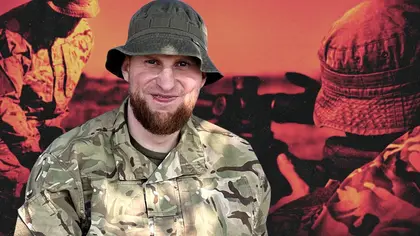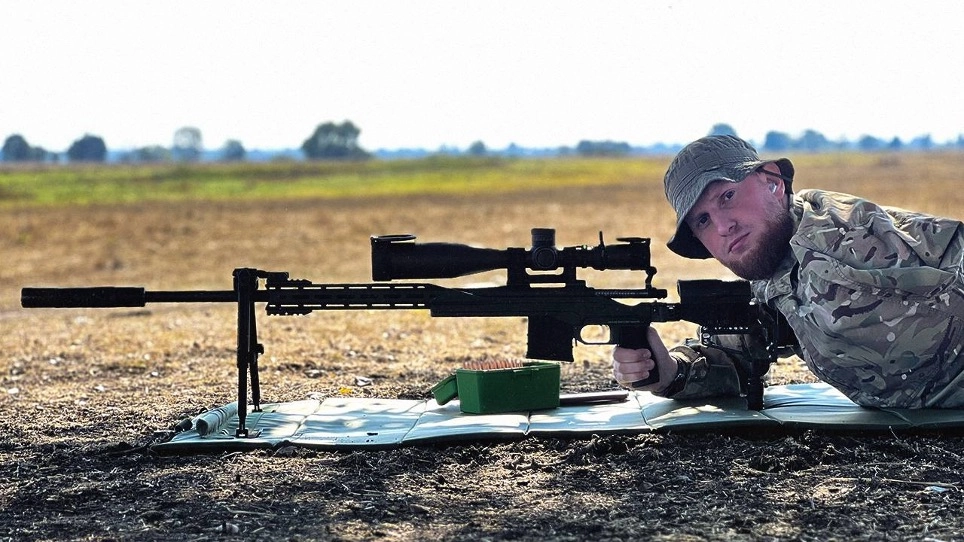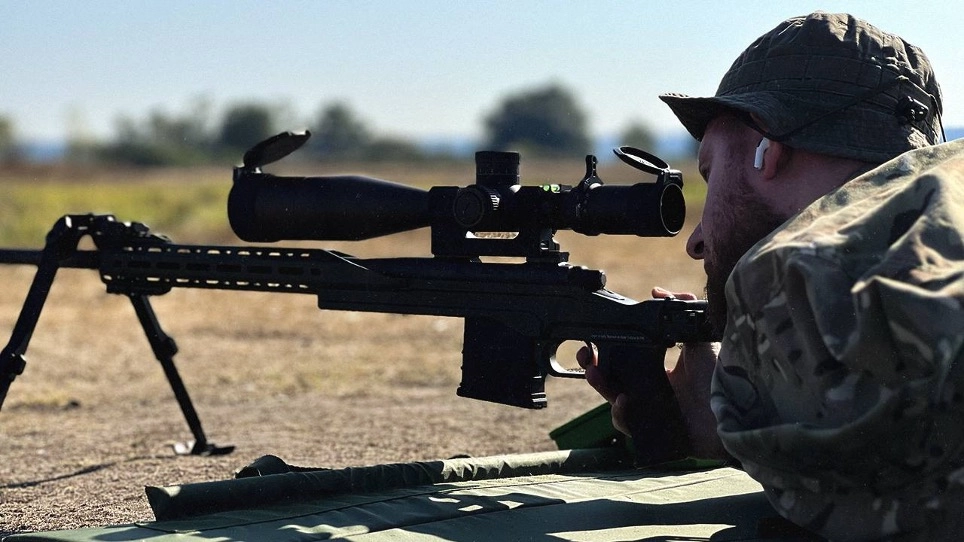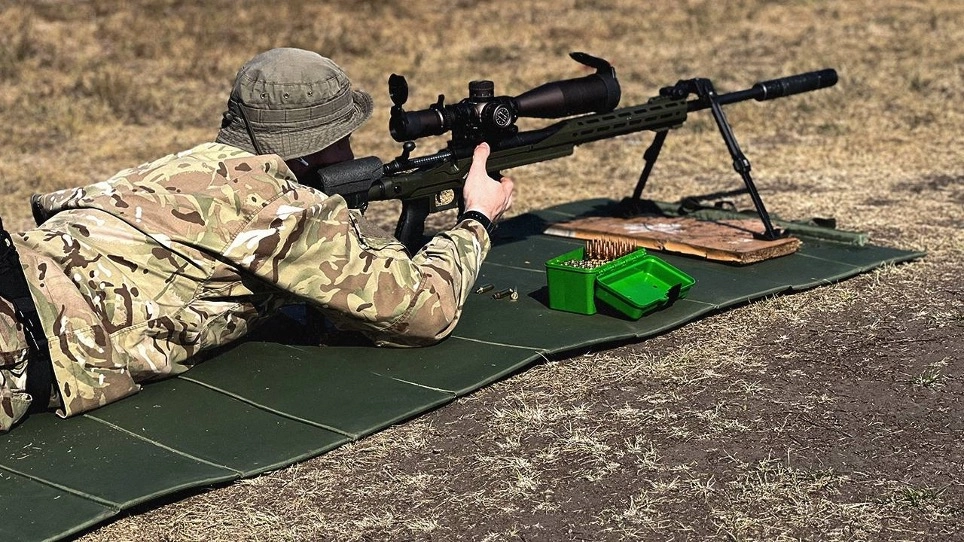When it comes to “snipers,” most people imagine something out of the movies – a mysterious man, concealed from view waits for the target, at just the right time, he shoots, the target is eliminated, and the sniper rides off into the sunset.
“In fact, the story of sniping is very romanticized,” Dmytro Finashyn, a sniper and drone operator, told Kyiv Post while working at a military training ground. And drones are taking over a lot of their duties, he said.
JOIN US ON TELEGRAM
Follow our coverage of the war on the @Kyivpost_official.
Finashyn – call sign “Fin” – has been serving in the Armed Forces of Ukraine since 2015.
He worked as a sniper and drone operator for the first three months of the full-scale invasion of Ukraine, in an aerial reconnaissance platoon in the “Hero of Ukraine Maj. Gen. Serhiy Kulchytsky” Operational Battalion.
But in May of last year, Finashyn and his three comrades were ambushed. One soldier, from the Donbas unit, was killed immediately. Another, call sign “Azovchyk,” was injured.
Finashyn said the other soldier, call sign “Socrates,” dragged Azovchyk about 40 meters when a bullet passed through Finashyn’s finger on his right hand and another through his left forearm, embedding itself near his collarbone.
Socrates tried to find a safe way out of the wooded area but was found and killed by the Russians.
They took his radio and told the Ukrainians that they’d killed everyone.

‘Wild Hornets’ Latest Development Will ‘Sting’ Russian Shahed Drones
At that point, Finashyn’s unit stopped their rescue operation and Finashyn was on his own.
Azovchyk had crawled on trying to find the Ukrainian army but got lost in the woods. Fortunately for Azovchyk, they found him that evening.
But Finashyn, losing blood and in a daze, dragged himself forward for two days, always searching for his fellow soldiers.
“At night, the temperature reached four degrees so I tried to move so I wouldn't freeze,” Finashyn said.
“My water ran out on the first day and I had to drink from puddles. Sometimes I hallucinated and it seemed like our military was nearby,” he said.
Finally, he was found by another brigade.
His left arm and a finger on his right had to be amputated, but he considers these a small price to pay for his life.
“In fact, they held a funeral for me and the other soldier,” Finashyn said.
Finashyn was awarded the title Hero of Ukraine with the order of the Golden Star. Now he serves in the National Guard as an intelligence officer, engaged in analytics using drones.
Finashyn spoke to the Kyiv Post about what it’s like to be a sniper and how drones are replacing them in the war in Ukraine.
Drones are replacing snipers
Finashyn said that in the first three months of the full-scale war, before being ambushed, he only used his rifle four times. However, he was working with drones nearly every day.
“Now plastic works much better than humans,” Finashyn said. In the case of a sniper, “if you do something wrong, the whole operation ends with injury or death.”
Also because of the distances involved in the full-scale war, a sniper is less often called for. You’re usually either close enough that an AK-47 can do the job, or you’re so far enough that a drone is the best instrument.
Snipers have been known to shoot targets well over 1000 meters away, but that sort of shooting is less common now.
“During the full-scale invasion the longest distance I worked with was only 250 meters, and the smallest was 60,” Finashyn said.
A sniper can still have their uses though, particularly in an urban environment.
“Then it's more psychological pressure. The enemy will be afraid to walk knowing that snipers are working somewhere,” Finashyn said.
How much does it cost to be a sniper?
The Ukrainian army provides its snipers with a rifle and a sight, but there are often a lot of additional costs taken on by the individual snipers.
Often, snipers will opt to buy their own rifles based on their goals, skills, and finances.
Here’s how much an average “sniper kit” can cost:
· Optical sight ~ $5,200
· Optical mount ~ $800
· Rifle ~ $2,600
· Rifle case ~ $500
· Rifle stand ~ $400
· Range finder ~ $500-900
· Anemometer (wind meter) ~$900
Ammunition can also be expensive.
The minimum cost of the most popular cartridge among snipers, the 308-caliber, starts at $2.60, which is good for shooting from a distance of 200-400 meters. But the price of longer distance ammunition, like the 338-caliber cartridge can average $7.50. Other kinds of cartridges can range from $13 to $18 apiece. And during training, you need to take thousands of shots, Finashyn said.
Meanwhile, a kamikaze drone costs about $300 and can fly to an area and destroy everything nearby, Finashyn said.
What is sniper school like?
Merely having a desire to become a sniper isn’t enough, particularly as there are so many people wanting to do it.
“In fact, training a sniper is a big expense with little efficiency at the moment,” Finashyn said. “Therefore, most of those that are interested in being snipers instead become FPV (First Person View) drone operators,” he said.
Also, you don’t immediately become a sniper. Usually, after some experience in the army, a person establishes a reputation as a good shooter and then gets sent to sniper school.
In Ukraine, the program and duration of training varies depending on your department. You can also be sent abroad for advanced training.
Finashyn said that training is similar to other types of weapons’ training, but more specialized in some ways, for example, taking topography more into account.
“If you go to the first level, marksman (an infantry sniper), then you’ll practice clearing premises of enemy troops. The marksman is a full-time unit and works with his platoon, which may be tasked with entering a building,” Finashyn said.
“Theory teaches internal ballistics, what happens while the bullet is in the barrel bore. They also teach you everything that happens after it’s been shot. There are a significant number of factors impacting its flight,” Finashyn said.
What are the challenges of sharpshooting?
As most people understand, you’re typically dealing with large distances as a sniper.
The flight of a bullet is affected by air temperature, atmospheric pressure, humidity, the location of the person on the globe, the target’s distance, gunpowder temperature, the heating of the barrel, wind, and more.
“There are many factors that need to be considered. Every shot must be deliberate. What is happening around you should be calculated in advance. If you are already in position, you have already clearly defined everything,” Finashyn said.
During targeting, a sniper must carefully consider the wind, which by the way can change the appearance of the target.
However, an anemometer can help you figure out how the wind will affect the bullet’s movement. If you put it on a tripod with a weathervane and connect it to your smartphone, it will show the strength and direction of the wind. Now the procedure is simplified because technology allows you to calculate corrections.
Since the bullet is flying on a parabola, while it is flying, the sniper needs to calculate what kind of wind will be in the corridor along the road, and what kind of wind at a height of six meters.
“The bullet will carry with different forces depending on the height and distance. And the wind is not static, which significantly complicates the situation. It’s impossible to determine this, skills come with experience,” the Finashyn said.
What do snipers really do on the battlefield?
“Everyone immediately imagines snipers in costumes made of sticks and leaves making them absolutely invisible. But in fact, they’re not always needed,” Finashyn said.
In war, a sniper’s job varies. For example, there could be information about an enemy sniper’s position and the military might conduct counter-sniper activities.
Each side’s snipers might search for the others’ in a “mutual hunt.”
Snipers could be used for defensive or offensive positions.
They often prepare their positions ahead of time and wait for long periods of time. They often work in pairs to relieve one another and are set up in such a way that they can move in and out of their position.
“If you're already in a situation where you can't move then everything didn't go according to plan and then it won't be long-term,” Finashyn said.
“Everyone thinks they want to be snipers,” but it’s not a joy ride
“Sniping is not an adrenaline rush,” Finashyn said, who described it as slow, methodical. “This is not suitable for everyone.”
And when you’re a sniper, you’re not exactly staying at the Hilton.
“Once, at the beginning of the invasion, the military of the Special Operations Forces came, and I felt sorry for them. March – cold, wet. They came from a task and asked if there was a place to sleep.” Finashyn said that at the time his group had been living out of a HUMMMV for a week. “I looked at their pants, and they were so black and shiny that you couldn’t understand that they were camouflage military trousers.”
You can also highlight the text and press Ctrl + Enter









